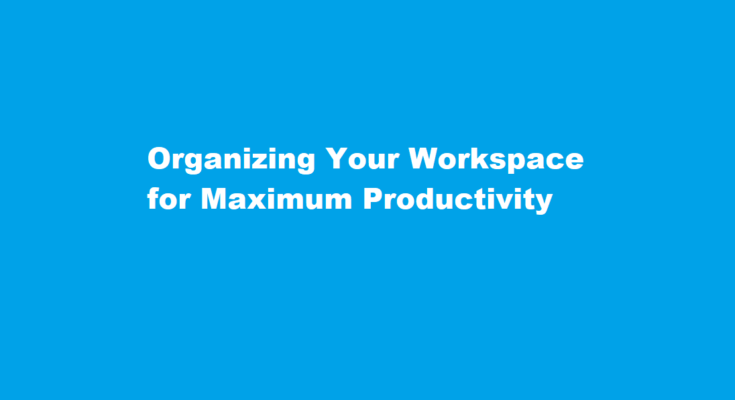Introduction
A cluttered and disorganized workspace can significantly impact your productivity, focus, and overall efficiency. An organized workspace can foster a positive work environment, boost creativity, and enhance your ability to complete tasks with ease. In this article, we will explore practical strategies and tips to help you transform your workspace into a well-organized and productive haven.
Decluttering is the First Step
Before you begin organizing, decluttering is essential. Remove unnecessary items, outdated documents, and broken equipment. A clutter-free space allows your mind to focus on the task at hand without unnecessary distractions. Be ruthless in purging items that you no longer need or use regularly.
Create Dedicated Zones
Divide your workspace into dedicated zones based on the tasks you perform. For instance, have a designated area for computer work, a separate space for writing or sketching, and another area for reference materials. By doing this, you create a mental association between each zone and the specific tasks, helping you switch focus effortlessly.
Invest in Proper Storage Solutions
Invest in storage solutions that suit your needs and preferences. File cabinets, shelves, and drawers are excellent options for keeping your materials and documents organized. Labeling containers and drawers further enhances accessibility and reduces the time spent searching for items.
Keep Frequently Used Items Within Reach
Place frequently used items close to your workstation to avoid unnecessary movements and interruptions. Keep the items you use daily, such as pens, notepads, and chargers, within arm’s reach. This simple adjustment will save valuable time and maintain your workflow.
Implement the “One Touch” Rule
Adopt the “One Touch” rule to tackle papers and documents efficiently. When you pick up a piece of paper or a document, take action immediately: file it, delegate it, or dispose of it. Avoid letting items pile up on your desk, as this only creates clutter and leads to procrastination.
Organize Digital Files
A cluttered digital environment can be just as detrimental as a physical one. Organize your computer files into well-labeled folders and remove any files you no longer need. Utilize cloud storage services to back up and access your files from anywhere, ensuring seamless productivity.
Embrace Minimalism
Adopting a minimalist approach can significantly improve your workspace’s productivity. Consider only keeping essential items visible, reducing distractions, and promoting a calm and focused atmosphere. Minimalism encourages a clear mind and empowers you to concentrate on the tasks at hand.
Utilize Ergonomic Furniture
Invest in ergonomic furniture to support your health and well-being while working. An ergonomic chair, adjustable desk, and proper monitor positioning can help prevent physical discomfort and enhance focus and productivity throughout the day.
Personalize Your Workspace
While minimalism is crucial, adding personal touches to your workspace can create a motivating and inspiring environment. Displaying meaningful photographs, inspiring quotes, or artwork can positively influence your mood and encourage creativity.
Maintain Regular Cleaning Sessions
Incorporate regular cleaning sessions into your routine to prevent clutter from accumulating again. A quick five to ten-minute tidying up at the end of each workday can significantly impact your workspace’s organization and set the stage for a productive start the next day.
Digital Detox and Time Management
Limit your exposure to digital distractions by scheduling regular digital detox sessions. Disconnect from social media, email, and other non-essential apps during focused work periods. Implement time management techniques, such as the Pomodoro Technique, to work in focused intervals with short breaks in between.
Prioritize Task Management
Effective task management is crucial for maximum productivity. Utilize tools such as to-do lists, project management software, or time-tracking apps to prioritize and manage your tasks efficiently. Breaking larger projects into smaller, manageable tasks can prevent overwhelm and improve productivity.
FREQUENTLY ASKED QUESTIONS
What is most important for maximizing productivity?
You can better control your energy and productivity levels if you have good time management abilities. Greater energy is one of the most essential advantages of time management. Increased energy allows you to concentrate on the most critical tasks. Maintain a high level of energy to manage your time better.
What improves workplace productivity?
It can be helpful to take short breaks, move around, switch locations, put on some music, meditate and eat lunch with your co-workers. Create daily goals and to-do lists to prioritize and delegate your tasks efficiently. This article is for anyone looking to improve their workplace productivity.
Conclusion
Organizing your workspace for maximum productivity is a gradual process that requires consistent effort and dedication. By decluttering, creating dedicated zones, investing in proper storage solutions, and maintaining a minimalist approach, you can transform your workspace into a productive haven. Embrace ergonomic furniture, personalize your space, and maintain regular cleaning sessions to optimize your work environment further. Remember to implement digital detox sessions and prioritize task management to enhance focus and productivity throughout your workday. With these strategies in place, you’ll be better equipped to tackle tasks efficiently, boost creativity, and achieve your professional goals with ease.
Read Also : Troubleshooting Common Computer Problems A Comprehensive Guide



